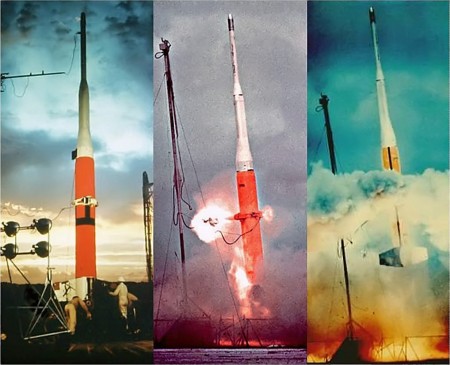Fifty-seven years ago this week, the triple-staged USAF/Lockheed X-17 successfully flew its first aerodynamic heating research mission. The hemispheric reentry test article achieved a peak Mach number of 12.84 during the high temperature flight experiment.
In the early 1950’s, the United States began developing its first stable of Intercontinental Ballistic Missiles (ICBM’s). Among the many technical issues facing engineers at that time, perhaps the most vexing was that of reentry vehicle survivability owing to the extreme temperatures encountered in hypersonic flight. These high temperatures resulted from the flow deceleration which occurred within the reentry vehicle bow shock wave as kinetic energy was transformed to thermal energy.
The temperatures within the shock layer of a hypersonic reentry vehicle can exceed 10,000 degrees Fahrenheit. Indeed, there is enough kinetic energy in the flow that should it all be converted to thermal energy, the reentry vehicle material would be vaporized. The pressing challenge in the 1950’s was to determine how to shape the vehicle such that the kinetic-to-thermal energy conversion process transferred most of the energy to the air rather than the vehicle.
H. Julian Allen and Alfred Eggers of the National Advisory Committee for Aeronautics (NACA) discovered that a blunted forebody would significantly reduce the magnitude of aerodynamic heating relative to that of a sharp or pointed body. However, the concept needed to be tested to confirm its validity. Wind tunnels that could provide full-scale flight Mach number, Reynolds number, and temperature similitude did not exist at the time. Thus, the only recourse was flight test.
The X-17 Program was established to provide the first hypersonic, high-altitude flight data relative to entry vehicle aerodynamic heating. The United States Air Force contracted with Lockheed for development of a vehicle capable of boosting reentry vehicle test articles to hypersonic flight conditions. The idea was to acquire aerodynamic heating data for various reentry vehicle shapes. The fast-paced program was driven by the urgency of national defense interests.
The Lockheed-developed X-17 was a three-stage vehicle. It measured 40.5 feet in length and had a maximum diameter of 31 inches. The first stage rocket motor did the heavy lifting. The Thiokol XM-20 solid rocket motor produced an average thrust of 48,000 lbs for 28 seconds. Burnout occurred at Mach 5 and 90,000 feet.
Following first stage burnout, the entire X-17 launch stack coasted to an apogee of about 500,000 feet. The vehicle went over the top at around Mach 0.8. The gravitationally-aided fall back toward the earth caused the vehicle’s velocity to build-up rapidly. Indeed, as the X-17 passed through 120,000 feet on the way downstairs, the Mach meter reading was back up to 5.
Second stage propulsion consisted of a trio of Thiokol XM-19 rocket motors which produced a combined thrust of 101,700 lbs for 1.5 seconds. These motors were ignited shortly after the empty first stage was jettisoned. The resulting high acceleration drove the vehicle to a Mach number approaching 10 as the X-17 passed through 72,000 feet. The second stage was jettisoned just after burnout.
A single XM-19 rocket motor comprised third stage propulsion. Peak acceleration was better than 90 g’s resulting in the X-17 payload reaching a burnout Mach number of about 14 at 55,000 feet. The temperature measurement period between maximum Mach number and Mach 2 was brief; on the order of 10 seconds. These temperature data were telemetered to the ground since the test article was completely destroyed at impact.
The first X-17 aerodynamic heating research mission was launched on Wednesday, 17 July 1956 from the Air Force Missile Test Center (AFMTC) near Cape, Canaveral Florida. The X-17 system worked well as the hemispheric reentry vehicle test article reached a maximum velocity of 8,184 mph or Mach 12.84. Apogee for this first X-17 research mission occurred at an altitude of 465,000 feet.
A total of twenty-five (25) aerodynamic heating research missions would ultimately be flown during the X-17 Program. The last of which occurred in March of 1957. This very successful test effort produced a wealth of first-ever heat transfer data that helped write the book on reentry vehicle design. Key findings included the effects of boundary layer transition, external shape, and high temperature material thermal response.
The X-17 Program was among the most important of the 1950’s. Indeed, both the Atlas and Titan Programs conducted initial tests of their respective reentry vehicle designs using the X-17 as a testbed. The upshot of this is that the United States was able to develop survivable reentry vehicles in a timely fashion during the height of the Cold War.



Comments
Excellent info – I’m building a rare 1950s model kit of this rocket and found the details and history very useful. Thanks.
Share this post: